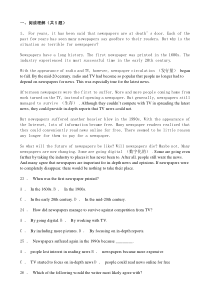 DOC
DOC
【文档说明】中考英语二轮专题复习 阅读理解 说明文四(含答案).doc,共(9)页,63.241 KB,由MTyang资料小铺上传
转载请保留链接:https://www.ichengzhen.cn/view-181127.html
以下为本文档部分文字说明:
一、阅读理解(共5题)1、Foryears,ithasbeensaidthatnewspapersareatdeath’sdoor.Eachofthepastfewyearshasseenmanynewspaperssaygoodbyetotheirreaders
.Butwhyisthesituationsoterriblefornewspapers?Newspapershavealonghistory.Thefirstnewspaperwasprintedinthe1600s.The
industryexperienceditsmostsuccessfultimeintheearly20thcentury.WiththeappearanceofradioandTV,however,newspapercircu
lation(发行量)begantofall.Bythemid-20century,radioandTVhadbecomesopopularthatpeoplenolongerhadtodependonnewspapersfornews.Thiswasespeciallytruefo
rthelatestnews.Afternoonnewspaperswerethefirsttosuffer.MoreandmorepeoplecominghomefromworkturnedontheTV,insteadofopeningane
wspaper.Butgenerally,newspapersstillmanagedtosurvive(生存).Althoughtheycouldn’tcompetewithTVinspreadingthel
atestnews,theycouldprovidein-depthreportsthatTVnewscouldnot.Butnewspaperssufferedanotherheavierblowinthe19
90s.WiththeappearanceoftheInternet,lotsofinformationbecamefree.Manynewspaperreadersrealizedthattheycouldconvenientlyreadnewsonlinefor
free.Thereseemedtobelittlereasonanylongerforthemtopayforanewspaper.Sowhatwillthefutureofnewspapersbelike?Willnewspapersdie?Maybenot.Manyn
ewspapersarenowchanging.Somearegoingdigital(数字化的).Somearegoingevenfartherbytakingtheindustrytoplacesithasneverbeento.A
fterall,peoplestillwantthenews.Andmanyagreethatnewspapersareimportantforin-depthnewsandopinions.Ifnewspapersweretocompletely
disappear,therewouldbenothingtotaketheirplace.23.Whenwasthefirstnewspaperprinted?A.Inthe1600s.B.Inthe1900s.C.Intheearly20thcentury.D.Inthemid-20th
century.24.HowdidnewspapersmanagetosurviveagainstcompetitionfromTV?A.Bygoingdigital.B.ByworkingwithTV.
C.Byincludingmorepictures.D.Byfocusingonin-depthreports.25.Newspaperssufferedagaininthe1990sbecause________.A.peoplelostinterestinreadingnewsB.newspa
persbecamemoreexpensiveC.TVstartedtofocusonin-depthnewsD.peoplecouldreadnewsonlineforfree26.Whichofthefollowingwouldth
ewritermostlikelyagreewith?A.Thefutureofnewspapersishopeless.B.Thefutureofnewspapersisstilluncertain.C.Manynewspa
perswilldieinthenearfuture.D.Afternoonnewspaperswillbecomepopularagain.2、Babieswillnaturallysharefoodwithhungrystrangers,evenwhenthey’r
ehungrythemselves,accordingtoanewstudypublishedinScientificReports.Inthestudy,theresearchersfirstdidan
experimenton19-month-olds.Thetimewasabout75minutesaftertheirlastsnackormeal.Intheexperiment,anunfamiliaradultreachedforpiecesoffreshfruitthathad
beenplacedonadishinfrontofachild,andthechildcouldchoosetoeithersharethefruitwiththeadultorkeepthefruitandeatithimself/herself.Almost60%o
fthechildrensharedatleastonepieceoffruitwiththeadult.Inafollow-upexperiment,theresearchershadthechildren’sparentsbringtheminjustbeforetheirnextsch
eduledsnackormeal,soonaverage,ithadbeenmorethan130minutessincetheylastate.Theresearcherswantedtoknowwhetherthesechildren,whowerehun
grythemselves,wouldstillsharefoodwithsomeoneinneed.Theresultsshowedthatalmost40%ofthechildrenwerewillingtoshareatleastonepieceoffruitwith
theadultwhoreachedforthefood.Someotherexperimentresultsalsoshowedthatchildrenasyoungasoneyearoldlikedtohelpothe
rsinneed,evenwhentheythemselveswantedtogetsomething.26.Wherecanwereadthenewstudy?A.Inachildren’sbook.B.InScientific
Reports.C.Inthefoodmagazine.D.Inapopularnewspaper.27.Whomdidtheresearchersdothefirstexperimenton?A.Someadults.B.19-monthbabies.C.Children’sparents.D.
Manystrangers.28.Whatdoestheunderlinedword“scheduled”mostprobablymean?A.Leftthedaybefore.B.Overcooked.C.Plannedaheadoftime.D.Home-
made.29.Whatcanweknowfromthethirdandfourthparagraphs?A.Thebabiesatethingsveryslowly.B.Thebabiesdidn’tlikesnacksorm
eals.C.Thoughyoung,thebabiessharedfoodwithparents.D.Thoughhungry,thebabieswerestillwillingtoshare.30.Whydidtheresearcherscarryouttheexp
eriments?A.Toshowbabiesliketosharenaturally.B.Toknowhowmuchchildrencaneat.C.Toteachchildrenhowtohelpothers.D.Toa
dviseadultstolookafterbabies.3、Whatisatsunami(海啸)?Tsunamisareoftencausedbyearthquakesorvolcanoes(火山).Theaveragespeed(平均速度)ofthewaves(波浪)is300mphandth
ewavescanlastfromfiveminutestoanhour.Whattodoinatsunami?Firstly,whenastrongearthquakeisfelt,leavethewateratonce,gettotheshore(海岸)andgoasfarawayasyo
ucanfromthebeachfast.Ifitallows,gotoahigherground.Secondly,turnontheTVfornewsandweatherreport.Theywilltellyoumoreaboutthetsunami.Thirdly,getallm
embersofyourfamilytogetherandleteveryoneknowthetsunamiiscoming.Chooseaplacetostaytogether.Makesuretheplaceissafea
ndasfarawayfromtheshoreaspossible.Bringemergencysupplies(应急用品)whenyouhavetoleaveyourhouse.Atlast,ifyoufindahuge
waveiscoming,climbontotheroofofyourhouseoronthehighestpointofthenearestbuilding.Holdontoanythingthat’sstrongenough.Climbatree
ifyouhaveto.Foratsunami,theonlywaytosurvive(幸免于)itistobeprepared.31.Whenatsunamicomes,thewaveswill________.A.goasquicklyas
300mphB.becomestrongerbeforetheearthquakeC.causeheavyrainD.lastshorterandshorter32.Howmanysuggestion
sarementionedinthispassage?A.Two.B.Three.C.Four.D.Five.33.Whenatsunamiiscoming,yourfamilyhadbetter_____
___.A.gotothebeachtogetherB.stayinasafeplacetogetherC.stayinyourhouseD.putemergencysuppliesonalowerground34.Wes
houlddothefollowingwhenatsunamiiscomingEXCEPT________.A.listeningtotheweatherreportB.goingtoalowplacetokeepsafeC.gettingemergencysuppliesreadyD.le
avingthewaterasfarawayasyoucan35.What’sthebesttitleofthepassage?A.HowtokeepsafeinthewaterB.WhatatsunamiisC.WhattodoafteratsunamiD.Howtosur
viveatsunami4、Mostofusareusedtousingjethanddryers(喷射式干手器)inpublicrestrooms.They’resurelyveryconvenient—allweneedtodoistoholdupourhandsforafewsecond
suntilthey’redry.Andmoreimportantly,they’resupposedtobehygienic(卫生的).However,anewstudypublishedinthejournalHospitalInfectionfoundthatjethan
ddryersactuallyspreadmoredangerousbacteria(细菌)thanpapertowels.Inthestudy,tworestroomsineachofthreedifferenthospitalsintheUK,Franceand
Italywererequiredtoprovidebothjetairdryersandpapertowelsforpeopletouse.Butoncertaindays,onlyeitherthehanddryerorthepaperto
weldispenser(自动出纸机)wasavailabletouse.Thescientistsfoundthatwhenonlythehanddryerwasavailable,theamountofbacteriaintherestroomswas27timeshigherthan
onotherdays.AccordingtostudyleaderMarkWilcox,anexpertinmedicalmicrobiology(微生物学)atLeedsUniversity,UK,airdryers
spreadharmfulbacteriaallovertheroom.Thismeansthatifpeopleusethesedryers,they’remorelikelytopickupbacteria.Atthesametime,h
owever,thisraisesthequestionofwhythesebacteriaexistinthefirstplaceifpeoplearewashingtheirhandsafterusingth
erestroom.“Theproblemstartsbecausesomepeopledonotwashtheirhandsproperly,”WilcoxtoldTheTelegraph.Inotherwords,poorhand-washingleadstoalargeamountofbac
teriabeingleftonyourhands.39.Whatdidthenewstudyfindaccordingtothepassage?A.Usingjethanddryerswasveryconvenient.B.Jethandd
ryersweresupposedtobehygienic.C.Jethanddryersactuallyspreadmoredangerousbacteriathanpapertowels.D.Hos
pitalswererequiredtoprovidebothjetairdryersandpapertowelsforpeopletouse.40.Howcanwestopbacteriaaccordingtot
helastparagraph?A.Byusingpapertowels.B.Byonlyusingjethanddryers.C.Bynotusingpublicrestrooms.D.Bywashingourhandsproperly.41
.Whatcanwelearnfromthepassage?A.Washinghandscanprotectyoufromdanger.B.Moderntechnologymaycausemoreproblems.C.It
’scommontopickupbacteriainpublicplaces.D.Scientistswillfindawaytoimprovehanddryers.5、DoyouknowanyonebornintheYearoftheTiger?What’stheirpersonality
like?Aretheybrave,stronganddetermined?Ifso,thentheyareatypical“tiger”.InChineseculture,tigersareseenasthekingofallanimals.Th
eystandforpower,energyandprotection.Tigersareseenasfearlessanimals,sothat’swhyinChinayoucanseepictureso
ftigersonthewallsofhousesandtemplestowardoff(抵御)dangeranddisasters.TigershaveanimportantculturalmeaningnotjustinChina,
butacrossAsiawheretheyliveinthewild.Forexample,inSouthKorea,theanimalisasymbolofjustice,humanityandr
ighteousnessinlocalfolktales.Boththe1986SeoulAsianGamesandthe1988SeoulSummerOlympicsusedHodori,afriendlycartoontig
er,asthemascot.AtigerisalsoonthelogooftheSouthKoreanationalsoccerteam.IntheWest,tigersarealsoseenaspowerfulanimals.Andweofte
nuse“tiger”inEnglish.Ifwesaysomeone“workslikeatiger”,wemeanheorsheworkshard.Ifyouwantsomeonetocalmdown,youcansaytothem“easy,tiger”.Anotherfamo
usphraseis“eyeofthetiger”,whichmeanshavingstrength.Therearealsosomeotherphrasesabouttigers,suchas“atigercan’tc
hangeitsstripes”,“papertiger”and“haveatigerbythetail”.31.What’satypical“tiger”likeaccordingtothepassage?A.Smartandbrave.B.Braveandstrong.C.Strongando
utgoing.D.Determinedandfriendly.32.WhycanpeopleseepicturesoftigersonthewallsofhousesandtemplesinChina?A.BecausetigersliveinthewildinA
sia.B.BecausetigersareusedinEnglishphrases.C.Becausetigersareregardedasfearlessanimals.D.Becausetigersareus
edasthemascotsbothintheAsianGamesandintheOlympics.33.Ifwewantsomeonetocalmdown,wecanuse“_________”.A.easy,tigerB.worklike
atigerC.eyeofthetigerD.atigercan’tchangeitsstripes34.What’sthebesttitleofthepassage?A.TigersindifferentculturesB.TigersindifferentphrasesC.Tig
ers—thekingofallanimalsD.Tigers—theculturalsymbolinChina============参考答案============一、阅读理解1、A24.D25.D26.B【导语】本文是一篇说明文,主要介
绍了报纸的历史、兴衰、以及未来趋势。23.细节理解题。根据“Thefirstnewspaperwasprintedinthe1600s.”可知,第一份报纸印刷于17世纪。故选A。24.细节理解题。根据“Althoughtheycouldn’tcomp
etewithTVinspreadingthelatestnews,theycouldprovidein-depthreportsthatTVnewscouldnot.”可知,报纸能在电视的竞争中生存下来是因为它们可以提供电视新闻无法提供的深度报道。故选D。25.细节理解题
。根据“WiththeappearanceoftheInternet,lotsofinformationbecamefree.Manynewspaperreadersrealizedthattheycouldconvenientlyreadnewsonlineforfre
e.Thereseemedtobelittlereasonanylongerforthemtopayforanewspaper.”可知,20世纪90年代,报纸再次受挫,是因为人们可以免费在线阅读新闻,所以人们似乎再也没有理由为报纸付费了。
故选D。26.推理判断题。根据“Sowhatwillthefutureofnewspapersbelike?Willnewspapersdie?Maybenot.”可知,作者认为报纸的未来是不确定的,故选B。2、B27.B28.C29.D30.A【导语】本文介绍了婴儿
会与饥饿的陌生人分享食物,即使他们自己也饿了的相关科学研究情况。26.推理判断题。根据“Babieswillnaturallysharefoodwithhungrystrangers,evenwhenthey’rehungrythemselves,according
toanewstudypublishedinScientificReports.”可知,这是一份科学报道,故选B。27.细节理解题。根据“Inthestudy,theresearchersfirstdidanexper
imenton19-month-olds.”可知,研究中,研究人员首先对19个月大的婴儿进行了实验,故选B。28.词义猜测题。根据“Inafollow-upexperiment,theresearchers
hadthechildren’sparentsbringtheminjustbeforetheirnextscheduledsnackormeal”可知,研究人员让孩子的父母在他们下一顿零食或正餐之前把他们带进来,此处的单词“scheduled”指的是“提前计划的”,故选C。29
.段落大意题。根据“Theresearcherswantedtoknowwhetherthesechildren,whowerehungrythemselves,wouldstillsharefoodwithsomeoneinneed.”以及“Theresultssh
owedthatalmost40%ofthechildrenwerewillingtoshareatleastonepieceoffruit...evenwhentheythemselveswantedtogetsomething.”可知,三四两段主要是阐述虽然婴儿们饿了,但是他们还是愿意分享,故
选D。30.主旨大意题。根据“Babieswillnaturallysharefoodwithhungrystrangers,evenwhenthey’rehungrythemselves,accordingtoanewstudypubl
ishedinScientificReports.”可知,研究人员进行这些实验主要是为了展示婴儿喜欢自然地分享,故选A。3、A32.C33.B34.B35.D【导语】本文讲述海啸来临时,人们怎样应对海啸的四点建议。31.细节理解题。根据第一段“Theaveragespeedofthewav
esis300mph”,可知海啸来的时候波浪的平均速度可以达到每小时300英里。故选A。32.推理判断题。根据“Firstly”,“Secondly”,“Thirdly”及“Atlast”,可知,文章主要讲述了四点建议。故选C。33.细节理解题。根
据第五段“Thirdly,getallmembersofyourfamilytogetherandleteveryoneknowthetsunamiiscoming.Chooseaplacetostaytogether.Makes
uretheplaceissafeandasfarawayfromtheshoreaspossible”,可知当海啸来临,家人最好在一个安全的地方待在一起。故选B。34.推理判断题。根据倒数第二段“climbontotheroofofyou
rhouseoronthehighestpointofthenearestbuilding.Holdontoanythingthat’sstrongenough.Climbatreeifyouhaveto”,可知,爬到房子的屋顶或者最近的建筑楼的
最高点,爬到树上,可知B选项“去一个低处保证安全”表述错误。故选B。35.标题概括题。根据第二段“Whattodoinatsunami”,可知,文章讲述海啸的时候人们应该做些什么,可概括为“Howtosurvive
atsunami”。故选D。4、C40.D41.B【导语】本文介绍了在公共卫生间使用喷射式干手器传播更多的危险细菌,这主要原因是人们在上完厕所后不正确的洗手方式导致大量的危险细菌留在人们的手上所致。39.细节理解题。根据“Thescientistsfound
thatwhenonlythehanddryerwasavailable,theamountofbacteriaintherestroomswas27timeshigherthanonotherdays.”可知,科学家们发现,当只有烘干机可用时,厕所里的细菌数量是其他
日子的27倍。由此推知,喷气式烘手机实际上比纸巾传播更多危险的细菌,故选C。40.推理判断题。根据“Inotherwords,poorhand-washingleadstoalargeamountofbacteriabeingleftonyourhands.”可知,洗手不当会导致大量细菌留在
手上,所以作者建议正确洗手,故选D。41.推理判断题。根据“Thescientistsfoundthatwhenonlythehanddryerwasavailable,theamountofbacteriainthe
restroomswas27timeshigherthanonotherdays.”可知,烘干机比纸巾传播更危险的细菌,由此推知,现代技术可能会引起更多的问题。故选B。5、B32.C33.A34.A【导语】本文主要介绍了老虎在中国以及其它国家的意义。31.细节理解题。根据“Arethe
ybrave,stronganddetermined?Ifso,thentheyareatypical“tiger”.”可知,典型的“老虎”是勇敢、强壮、有决心的。故选B。32.细节理解题。根据“Ti
gersareseenasfearlessanimals,sothat’swhyinChinayoucanseepicturesoftigersonthewallsofhousesandtemplestowardoff(抵御)dangeranddisasters
.”可知,老虎被视为无所畏惧的动物,这就是为什么在中国,你可以在房屋和寺庙的墙上看到老虎的图片,以抵御危险和灾难。故选C。33.细节理解题。根据“Ifyouwantsomeonetocalmdown,
youcansaytothem“easy,tiger”.”可知,如果你想让某人冷静下来,你可以对他们说“easy,tiger”。故选A。34.最佳标题题。本文主要介绍了老虎在中国以及其它国家的意义,选项A“不同文化中的老虎”符合主题,故选A。
 辽公网安备 21102102000191号
辽公网安备 21102102000191号
 营业执照
营业执照